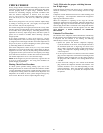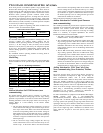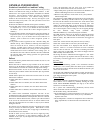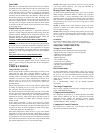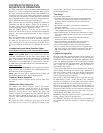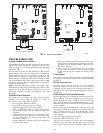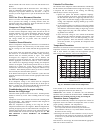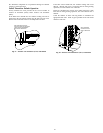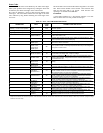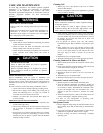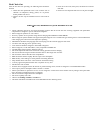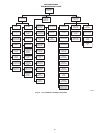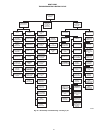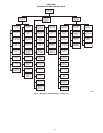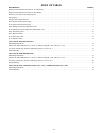
78
CARE AND MAINTENANCE
To assure high performance and minimize possible equipment
malfunction, it is essential that maintenance be performed
periodically on this equipment. The frequency with which
maintenance is performed is dependent on such factors as hours of
operation, geographic location, and local environmental
conditions.
ELECTRICAL SHOCK HAZARD
Failure to follow this warning could result in personal injury
or death.
Disconnect all electrical power to unit before performing any
maintenance or service on outdoor unit. Remember to
disconnect power supply to air handler as this unit supplies
low--voltage power to the outdoor unit.
!
WARNING
The minimum maintenance that should be performed on this
equipment is as follows:
1. Check outdoor coil for cleanliness each heating and cooling
season and clean as necessary.
2. Check fan motor and blade for cleanliness each month
during cooling season and clean as necessary.
3. Check electrical connections for tightness and controls for
proper operation each cooling season and service as
necessary.
CAUTION
!
UNIT DAMAGE HAZARD
Failure to follow this caution may result in equipment
damage or improper operation.
Because of possible damage to the equipment or personal
injury, maintenance should be performed by qualified
personnel only.
Desert and Seacoast Locations
Special consideration must be given to installation and
maintenance of condensing units installed in coastal or desert
locations. This is because salt and alkali content of sand adheres to
aluminum fins of coil and can cause premature coil failure due to
corrosion.
Preventive measures can be taken during installations, such as:
1. Locate unit on side of structure opposite prevailing winds.
2. Elevate unit to height where drifting sand cannot pile up
against coil. Mounting feet, 4 in. high, are available as
accessories and can be used to elevate unit.
3. Addition of coastal filter (See Product Data Digest for
accessory listing).
Maintenance in desert and seacoast
locations:
1. Frequent inspection of coil and basepan especially after
storms and/or high winds.
2. Clean coil by flushing out sand from between coil fins and
out of basepan as frequently as inspection determines
necessary.
3. In off season, cover with covering that allows air to circulate
through but prevents sand from sifting in (such as canvas
material). Do not use plastic as plastic will hold moisture
possibly causing corrosion.
Cleaning Coil
1. Remove top cover. (See Remove Top Cover in Cabinet
section of this manual.)
2. Remove coil grilles or louvers (as applicable) to gain full
access to coils for cleaning.
UNIT DAMAGE HAZARD
Failure to follow this caution may result in equipment damage
or improper operation.
Coil fin damage can result in higher operating costs or
compressor damage. Do not use flame, high--pressure water,
steam, volatile or corrosive cleaners on fins or tubing.
CAUTION
!
3. Clean coil using vacuum cleaner and its crevice tool. Move
crevice tool vertically, close to area being cleaned, making
sure tool touches only dirt on fins and not fins. to prevent
fin damage, do not scrub fins with tool or move tool
horizontally against fins.
4. If oil deposits are present, spray coil with ordinary
household detergent. Wait 10 minutes, and proceed to next
step.
5. Using garden hose, spray coil vertically downward with
constant stream of water at moderate pressure. Keep nozzle
at a 15-- to 20_ angle, about 3 in. from coil face and 18 in.
from tube. Spray so debris is washed out of coil and
basepan.
6. Reinstall top cover and position blade.
7. Reconnect electrical power and check for proper operation.
Cleaning Outdoor Fan Motor and Blade
1. Remove fan motor and blade. Be careful not to bend or dent
fan blade.
2. Clean motor and blade with soft brush or cloth. Be careful
not to disturb balance weights on fan blade.
3. Check fan blade setscrew for tightness.
4. Reinstall fan motor and blade to top cover and check for
alignment.
5. Reinstall top cover and position blade.
6. Reconnect electrical power and check for proper operation.
Electrical Controls and Wiring
1. Disconnect power to both outdoor and indoor units.
2. Check all electrical connections for tightness. Tighten all
screws on electrical connections. If any connections appear
to be burned or smoky, disassemble the connection, clean
all parts and stripped wires, and reassemble. Use a new
connector if old one is burned or corroded, and crimp
tightly.
3. Reconnect electrical power to indoor and outdoor units and
observe unit through 1 complete operating cycle.
4. If there are any discrepancies in operating cycle,
troubleshoot to find cause and correct.
Refrigerant Circuit
1. Check refrigerant charge using the superheat method, and if
low on charge, check unit for leaks using an electronic leak
detector.
2. If any leaks are found, remove and reclaim or isolate charge
(pumpdown) if applicable. Make necessary repairs.
3. Evacuate, recharge, and observe unit through 1 complete
operating cycle.



